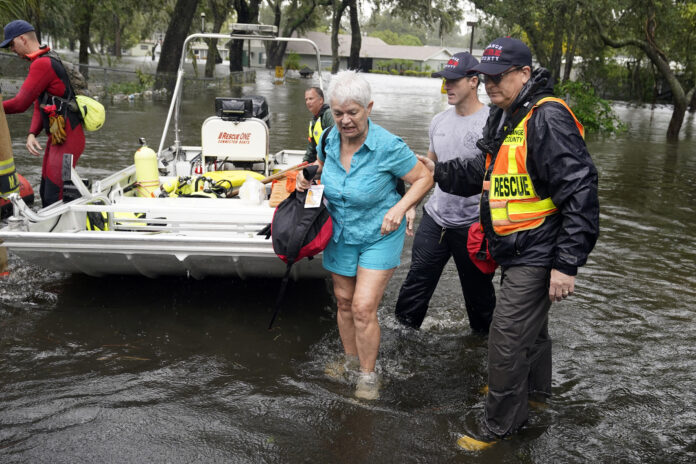Rescue crews piloted boats and waded through flooded streets Thursday to save thousands of Floridians trapped after Hurricane Ian destroyed homes and businesses and left millions in the dark.
The destruction began to come into focus a day after Ian made landfall in Florida as one of the strongest hurricanes ever to hit the U.S.
The storm flooded homes on both of the state’s coasts, cut off the only bridge to a barrier island, destroyed a historic waterfront pier and knocked out electricity to 2.67 million Florida homes and businesses, nearly a quarter of utility customers. At least one man was confirmed dead.
“We’ve never seen storm surge of this magnitude,” Florida Gov. Ron DeSantis told a news conference. “The amount of water that’s been rising, and will likely continue to rise today even as the storm is passing, is basically a 500-year flooding event.”
Though downgraded to a tropical storm by Thursday morning, the National Hurricane Center said storm surge and flooding rains remained a threat as Ian crept across the Florida peninsula and emerged in the Atlantic Ocean north of Cape Canaveral. Forecasters predicted Ian would regain some strength while turning northward.
A hurricane warning was issued for the South Carolina coast, where the storm was expected to again make landfall, having already hit Cuba and Florida.
Sheriffs in southwest Florida said 911 centers were inundated by thousands of stranded callers, some with life-threatening emergencies. The U.S. Coast Guard began rescue efforts hours before daybreak on barrier islands near where Ian struck, DeSantis said. More than 800 members of federal urban search and rescue teams were also in the area.
Damaged boats are seen in the wake of Hurricane Ian on Sept. 29 in Fort Myers Beach, Fla.
Wilfredo Lee/AP
She said her four-year-old daughter grabbed her hand and said: “I’m scared too, but it’s going to be OK.” The girl was right. The storm ripped away patio screens and snapped a palm tree in the yard, Bartley said, but left the roof intact and her family unharmed.
Trending Stories
Oakville teacher controversy: Ontario College of Teachers asked to review professional standards
Jeremy Mackenzie, ‘Diagolon’ founder and far-right figurehead, arrested
Authorities confirmed at least one Florida death — a 72-year-old man in Deltona who fell into a canal while using a hose to drain his pool in the heavy rain, the Volusia County Sheriff’s Office said. Two other storm deaths were reported in Cuba.
Lee County Sheriff Carmine Marceno said his office was scrambling to respond to thousands of 911 calls, but many roads and bridges in Fort Myers and the surrounding area were impassable.
“It crushed us,” Marceno told ABC’s “Good Morning America.” “We still cannot access many of the people that are in need.”
Emergency crews sawed through toppled trees to reach stranded people. Many in the hardest-hit areas were unable to call for help because of electrical and cellular outages.
“Portable towers are on the way for cell service. Chances are your loved ones do not have ability to contact you,” said the sheriff’s office in Collier County, which includes Naples. “We can tell you as daylight reveals the aftermath, it’s going to be a hard day.”
Hurricane Ian: Early reports indicate ‘substantial loss of life,’ Biden says
A chunk of the Sanibel Causeway fell into the sea, cutting off access to the barrier island where 6,300 people normally live. It was unknown how many heeded orders to evacuate, but Charlotte County Emergency Management Director Patrick Fuller expressed cautious optimism that worst-case scenarios might not have been realized.
No deaths or injuries have been confirmed in the county, and flyovers of barrier islands show “the integrity of the homes is far better than we anticipated,” Fuller said.
South of Sanibel Island, the historic beachfront pier in Naples was destroyed, with even the pilings underneath torn out, as towering waves crashed over the structure. “Right now, there is no pier,” said Penny Taylor, a Collier County commissioner.
Hurricane Ian: Biden approves Florida’s request for major disaster declaration
In Port Charlotte, a hospital’s emergency room flooded and fierce winds ripped away part of the roof, sending water gushing into the intensive care unit. The sickest patients — some on ventilators — were crowded into the middle two floors as the staff prepared for storm victims to arrive, said Dr. Birgit Bodine of HCA Florida Fawcett Hospital.
The Florida Highway Patrol shut down the Florida Turnpike in the Orlando area and said the main artery in the middle of the state will remain closed until water subsides.
Ian struck Florida as a monstrous Category 4 storm, with 150 mph (241 kph) winds that tied it for the fifth-strongest hurricane ever to hit the U.S.
Even after weakening, Ian’s tropical-storm force winds still reached 415 miles (667 kilometers) from its center. Forecasters predicted the Atlantic waters would strengthen it to a Category 1 hurricane before it makes landfall Friday in South Carolina.
The National Hurricane Center warned storm surge of 6 feet (1.83 meters) or more was possible from Daytona Beach, Florida, to north of Charleston, South Carolina. Rainfall of up to 8 inches (20.32 centimeters) threatened flooding in the Carolinas and Virginia.
“It doesn’t matter what the intensity of the storm is. We’re still expecting quite a bit of rainfall,” Robbie Berg, senior hurricane specialist with the National Hurricane Center, said in an interview with The Associated Press.
The U.S. Coast Guard initiated a search and rescue mission for 23 people after a boat carrying Cuban migrants sank Wednesday in stormy weather east of Key West. It found three survivors, and four others swam to shore, the U.S. Border Patrol said. Air crews continued to search for possibly 20 remaining migrants.
© 2022 The Canadian Press



